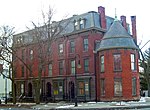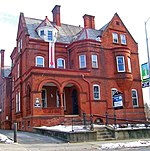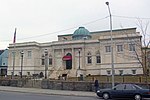Union Street Historic District (Poughkeepsie, New York)
1767 establishments in the Province of New YorkBuildings and structures in Poughkeepsie, New YorkHistoric districts in Dutchess County, New YorkHistoric districts on the National Register of Historic Places in New York (state)NRHP infobox with nocat ... and 2 more
National Register of Historic Places in Poughkeepsie, New YorkU.S. Route 9

The Union Street Historic District in Poughkeepsie, New York, United States, is an area of eight blocks (roughly 42 acres (17 ha)) southwest of downtown and just north of the Mid-Hudson Bridge approaches. It is the oldest neighborhood in the city.It dates to 1767 when a path to the Hudson River was developed into a street. In 1971 it was designated a historic district and became the first property in the city to be listed on the National Register of Historic Places.
Excerpt from the Wikipedia article Union Street Historic District (Poughkeepsie, New York) (License: CC BY-SA 3.0, Authors, Images).Union Street Historic District (Poughkeepsie, New York)
Union Street,
Geographical coordinates (GPS) Address Nearby Places Show on map
Geographical coordinates (GPS)
| Latitude | Longitude |
|---|---|
| N 41.703055555556 ° | E -73.933611111111 ° |
Address
Union Street 160
12601
New York, United States
Open on Google Maps










